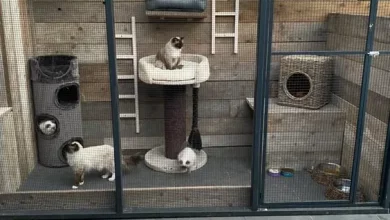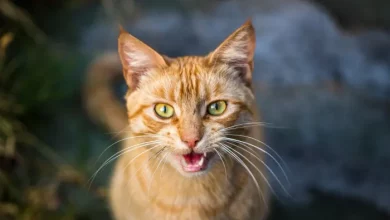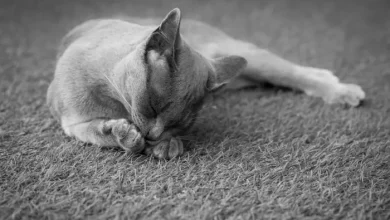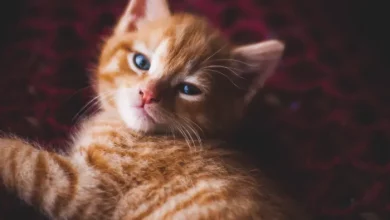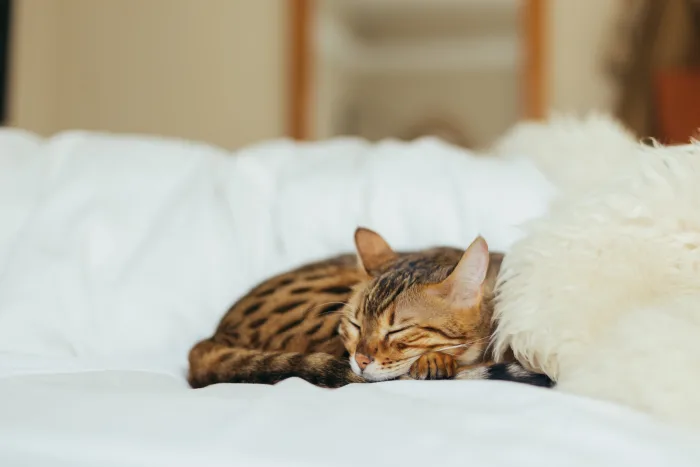
- The possible reason behind cats kneading is related to their early days as babies. Similar to what is observed in kittens while nursing, this rhythmic behaviour can also be seen in adult cats. As they nurse, a kitten kneads with both paws, which helps to increase the mother's milk production. In short, your cat's behaviour is instinctive.
My Feline Companion Purrs and Makes Biscuits
There is nothing more endearing than watching a cat knead or make biscuits. They love to seek out the cosiest blanket in the house (or even your tummy) and knead away as if in a trance, purring contently and staring off into space or fixating on their object of affection. They might even carry the blanket in their mouth (and drool!) and become completely absorbed.
This conduct signals to many cat owners that their pet is happy and affectionate, possibly creating a cosy spot to rest, groom or sleep. It’s adorable! However, this behaviour can be baffling, especially when an otherwise lively, confident, noisy cat kneads as if prepared to cuddle. Discover the origin of this amusing feline behaviour, its reasons, and whether it indicates your cat’s happiness and relaxation or is just an instinctual response.
What is the Reason behind Cats Kneading Blankets?
The possible reason behind cats kneading is related to their early days as babies. Similar to what is observed in kittens while nursing, this rhythmic behaviour can also be seen in adult cats. As they nurse, a kitten kneads with both paws, which helps to increase the mother’s milk production. In short, your cat’s behaviour is instinctive.
According to research, although milk contains hormones and growth factors that have small amounts of oxytocin, these levels decrease quickly after the initial days of breastfeeding. Instead, scientific studies propose that it’s the sucking action of newborns that triggers the release of oxytocin.
“Sucking at the udder in calves leads to increased oxytocin levels, which is not observed when drinking or lapping milk from a bucket. This phenomenon is triggered by the stimulation of sensory nerves in the oral mucosa during sucking.”
Hence, if your feline companion engages in kneading behaviour on blankets, soft surfaces, you, other pets, or even stuffed toys, the familiar motion of kneading and nursing triggers the pleasure centre of their nervous system. Moreover, if your cat purrs while doing so, it is a clear sign of their contentment.
What Is the Reason Behind Cats Kneading Their Owners?
Kneading is an action that brings back fond memories of a cat’s nursing experiences as a kitten, as previously mentioned. The comforting act of “making biscuits” enables them to relive those moments. When your cat kneads you, it shows their affection towards you, indicating that they feel at ease and have a loving attachment. It suggests that they seek your companionship and reassurance.
Regrettably, neglecting to regularly trim your cat’s claws can be pretty unbearable. When you’re lying in bed, your cat may approach you, climb onto your stomach, and inadvertently scratch you with their sharp nails. While you don’t wish to discourage their affection, it’s equally undesirable to end up with multiple tiny scratches all over your stomach.
To address this problem, it is advisable to keep a spare, soft and fuzzy blanket handy so that you can effortlessly place it over your stomach whenever your cat attempts to jump onto your lap or climb onto your bed and rest on your stomach. It is recommended to use fleece blankets as they are more effective and avoid those that can easily get torn into strings. Additionally, opt for washable blankets. Further valuable tips will be discussed below.
Recommended For You
Cats Also Use Kneading to Mark Their Territory
Cats are highly territorial, and kneading with their claws and paws on objects also emits their scent. Cats have scent glands on the underside of their paw pads that convey information to other cats about their presence, emotional state, reproductive condition, and further details.
If your female cat is unspayed, she may be kneading objects or the air as a sign that she is in her reproductive cycle and open for breeding. Other symptoms of her being in heat will also be apparent.
Please be aware that thousands of cats that could otherwise be adopted are euthanized yearly in the United States due to an overabundance of pets. You can assist in addressing this problem by having your pets spayed or neutered to avoid unintentional breeding. Furthermore, spaying or neutering your cat can also decrease unpleasant or undesirable behaviours, such as marking, yowling, spraying, and territorial aggression.
Tips for Preventing Your Cat from Inappropriate Kneading
While it’s not recommended to discourage your cat from kneading completely, training them to knead at appropriate times and places is important. Below are some tips that can help you get started:
Ensure your cat’s nails are trimmed every month. Create a designated spot where your cat feels comfortable kneading, such as a soft blanket placed strategically in your home. Provide your cat with a fixed bed or blanket in its favourite spot. Apply Feliway spray to their cosy space. This synthetic feline facial pheromone helps to create a “safe, friendly, comfortable” environment, making it valid for anxious cats. Keep treats close by and call your cat to a spot where they can knead without disrupting you. Pet them as they knead to help them relax. Avoid punishing your cat for unwanted behaviour. Instead, encourage appropriate behaviour by following the above tips.
Method for Trimming Your Cat’s Nails
If your cat’s nails cause you discomfort, they’re likely causing damage to your furniture too. Consider taking your cat to the vet once a month for a quick nail trim, or purchase a pair of nail trimmers and attempt the process yourself – provided your cat is cooperative. Here’s a guide on how to trim your cat’s nails:
Ensure that your cat is willing to let you touch their paws. Take one foot and gently press on the pad to expose the claws. Carefully clip off the pointed tips of the nails from left to right or proper to left, taking care not to cut them quickly. (The fast is the sensitive part of the nail bed that contains blood vessels and keeps the nail healthy.) Clipping the nails too low can be painful, cause bleeding, and may make your cat more resistant to future nail trims. Repeat the process for all four paws. Reward your cat with a treat after each foot or after the entire process is complete.
Note: Whenever you feel uncomfortable, or your feline companion appears to resist, avoid pushing them. Cats can be particular, and if you ruin an experience for them, it can be challenging to regain their trust.
Closing Thoughts
Overall, kneading is a harmless behaviour in cats. It is intended as a positive gesture, bringing them comfort as they act on instinct. It is crucial to recognize this behaviour as a positive one. If you do not want them to scratch your stomach, trim their nails or provide them with a soft and fluffy blanket. This conduct is one of the least concerning behaviours that your cat can exhibit. Often, it signifies that they are delighted, secure, affectionate, and ready for a long and peaceful nap.
This piece of writing is precise and authentic to the author’s knowledge. However, it cannot be used as a replacement for diagnosis, prognosis, treatment, prescription, or personalized guidance from a veterinary medical expert. If animals display any discomfort indications or symptoms, it is highly recommended that they be taken to a veterinarian at the earliest.

